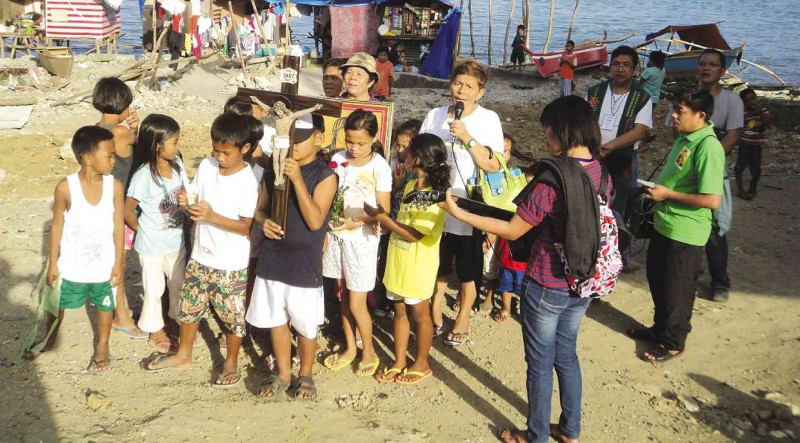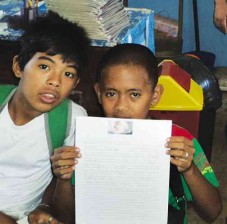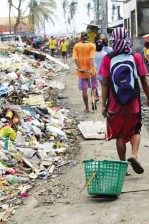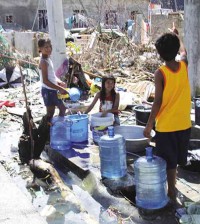Passion, death and resurrection

A boy carrying a cross leads a group of children and lay missionaries before Fr. Romeo Obach, CSsR, says Mass in Barangay Anibong in Tacloban City. PHOTO BY BRYAN ANGAYAN/CONTRIBUTOR
Instead of being a time of joy and hope, November and December last year might as well be the season of Lent, a time of grief and despair for some 16 million Filipinos living in 14 provinces along the path of Super typhoon “Yolanda” (international name: Haiyan).
Battered by the 378 kilometer-per-hour winds of “Yolanda” which precipitated a storm surge that hit Samar and Leyte, thousands of Filipinos across the six central regions underwent a calvary.
Struggle to rebuild
Today, five months since the tragic event, a big percentage of the survivors continue to carry a cross as they struggle to rebuild their lives. This is most especially true in Samar and Leyte, specifically Tacloban City, and the towns of Tanauan and Palo.
More than 80 percent of the calamity’s fatalities—estimated by the National Disaster Risk Reduction and Management Council (NDRRMC) at 6,268 individuals as of March 14—were reported from these places. A total of 1,069 persons remain missing and 28,689 were injured.
In the grounds of San Joaquin church in Palo is a mass grave where more than 600 bodies were buried. “I did not want the bodies that were scattered along the road to be subjected to the indignities as in other places,” says Fr. Kelvin Aporillo, the parish priest. “Thus, I made the quick decision to turn the church’s grounds as a mass grave as the bodies were starting to decompose and there was no other place where we could bury them.”
Unidentified
Only 350 bodies were identified and have marked graves; the others were unidentified.

Children take part in art therapy conducted by the Redemptorist General Mission. PHOTO BY BRYAN ANGAYAN/CONTRIBUTOR
Anita and Arnold Librea, a couple with three very young children (Kim, age 3; Jean, 2; and Joy, 6) evacuated to the Gabriela building in San Joaquin.
When the strong winds smashed the building, followed by the quick rise of the floodwaters, Arnold could no longer hold his eldest and youngest children. Kim and Joy drowned along with more than a dozen others who were trapped inside the building. Their bodies were buried in the mass grave.
The most dramatic graveyard is the one of Pedro Lacandazo’s family; 27 members of this extended family perished in this deluge.
Passion in poverty
The poverty statistics issued regularly by the National Economic and Development Authority (Neda) shows that Region VIII (which includes Samar and Leyte), is one of the poorest in the country.
In 2012, the poverty incidence was 63.7 percent in Eastern Samar, 50.0 percent in the rest of Samar, 43.0 percent in Southern Leyte and 39.2 in the rest of Leyte.
Long before Yolanda, these islands’ residents experienced a reality akin to a biblical Passion. From way back to the era of their ancestors, including the hero Agustin Sumuroy and the Balangiga rebels, the Warays have constantly faced hunger, deprivation and powerlessness owing to various factors—slave raiders from the south, oppressive colonization, the vagaries of a tropical climate, the difficulties of producing bountiful harvests despite available fertile lands, the prevalence of schistosomiasis and the tight grip of political dynasties.

A “cash-for-work-volunteer” pulls a laundry basket for collecting rubble. PHOTO BY BRYAN ANGAYAN/CONTRIBUTOR
Migrants from Samar have flooded Tacloban through the years, hoping to improve their lot, only to find themselves barely able to eke out a living. A city of 221,174 people (National Statistics Office, 2010), Tacloban’s population would expand to 1.2 million during weekdays.
Facing Cancabato Bay
Before “Yolanda” struck, thousands of households were packed in the coastal barangays facing Cancabato Bay. The majority has returned as there are no other places where the poor could live.
There are rich enclaves and middle-class settlements in parts of Tacloban and the adjacent towns but they constitute a small elite. While the playing field is leveled when a disaster strikes, nonetheless it is the poor who would suffer most.
Climate injustice
For the irony of the world today is manifested in the reality of climate injustice: Those most responsible for climate change—owing to affluent lifestyles and wasteful consumption patterns that involve the burning of fossil fuels—are the least affected when climactic disasters occur. The poor suffer far more when calamities strike.
This is most certainly true for those relying on fishing and farming, especially coconut farmers. “Yolanda” damaged 3.3 million coconut trees across 295,191 hectares of land, affecting one million farming households. With 30,000 boats damaged by the storm and fishing equipment such as nets and cages smashed, fisherfolk are desperately hoping they could find livelihood assistance.
The NDRRMC figure of 6,268 deaths is highly contested. Ordinary folks in Region VIII believe the number of deaths can easily be doubled. Some local governments and parishes are doing their own head count. The parish of San Jose where the airport is located counted more than 2,000 deaths. This number is already one-third of the official NDRRMC figure. In Barangays 88, 89 and 90 alone in San Jose, the number of deaths is 998.
Remains still being found
Ordinary people ask why the NDRRMC has stopped counting the fatalities even as the remains of those who perished continue to be found, although lately, there are no more bodies but just skeletons. People wonder why the state cannot provide the people with an accurate death statistics. They ask: Is there politics in the statistics of fatalities?
Folks on the ground are also asking why there are no longer aggressive action on the part of the police Scene of the Crime Operatives, the Department of Health and the fire departments to check the places where there could be bodies that have not yet been retrieved.
Violent death
At Barangay 88, the people are convinced that corpses are under the debris and piles of garbage at the boundary of their barangay with Barangay 87.
Jesus’ death by crucifixion remains one of the most violent manners of killing a presumed criminal. The death of thousands of “Yolanda’s” victims was no less violent. The stories told by survivors, who witnessed loved ones die, are harrowing and heartbreaking.
Death is no stranger to the Warays who constantly experience storms. But the numbers of fatalities are usually small, only those who would be hit by GI sheets blown by the strong wind or uprooted trees that fall on them. “Yolanda” is by far the worst catastrophe in terms of lost lives and property.
Various figures from both state and international aid agencies as to the number of houses damaged vary. Neda’s count is 1,192,091, of which 593,785 are reported to have incurred more than 50 percent damage. Neda placed the total damage and loss at P572.2 billion.
Cross folks carry
The net impact of these losses is the cross that the ordinary citizens carry today. Lucky are the few adopted by extended families or those who receive substantial foreign remittances. But the majority has no choice but to rebuild where their homes used to be.
As relief goods will definitely end soon along with the cash-for-work programs, many of those with no prospects of a livelihood feel very insecure these days. Many are frustrated by the slow recovery and weak rehabilitation response.
Weak bureaucracy
There have been a number of international aid agencies, nongovernment organizations and local business firms offering housing, livelihood and other rehabilitation assistance but their desire for quick action are constantly hampered by a weak and inefficient bureaucracy.
There is also the whole politics in which protecting turf, projecting their own accomplishments to their constituencies to get more funding, favoring the competence of foreigners while belittling the local staff’s experience and operating as lone wolves have blocked the needed collaboration among these agencies.
There have been attempts to set up coordination mechanisms (e.g. the Shelter Cluster), but by and large, the absence of stronger collaborative ties has also hampered fast recovery.
One of the most frustrating reality of working in the Samar and Leyte region has been the weak civil society network and the almost total absence of a public sphere where there could be more information sharing. If there was a strong civil society, pressure could be exerted to get the state and international aid agencies to be more transparent and be accountable in terms of the usage of their resources.
Transparency
With the assistance of The Asia Foundation, the units of the University of the Philippines based in Eastern Visayas, including Tacloban College and School of Health Sciences, sponsored the Yolanda Transparency Forum on March 20. This was an attempt to expand the public sphere and to listen to various voices of civil society and local government units demanding information sharing, transparency and accountability.
Just after this forum, the Tacloban City government issued its Proposed Tacloban Recovery and Rehabilitation Plan. It was prepared by the Tacloban Recovery and Sustainable Development Group, with support from the United Nations Development Program and inputs from the Shelter Program and the Alliance for Safe and Sustainable Reconstruction.
It is an awesome recovery plan on paper, with technical jargon that comes from highly sophisticated think tanks. But when asked if they knew something about this, a few barangay officials in San Jose answered in the negative.
Resurrection
A month after “Yolanda”, tarpaulins sprouted with the words Bangon! Tindog! (Rise up! Stand up!) On the part of the ordinary people, there is no doubt that they wish for a speedy recovery. They hope that their battered economy, the firms that could provide employment, and the institutions of education and health could all recover.
But apart from the well-established business firms with foreign and taipan capital, there is no upsurge of businesses re-establishing themselves. Many buildings housing these firms still need to be built again. Those that can be repaired are not rushing to reopen their doors for business transactions.
Local businessmen seem to take their time discerning if they would reopen and risk their capital once again. Having lost so much, other businessmen may no longer have the funds to set up their firms once again. As the economy is in the doldrums, the informal market remains sluggish.
Bright spot
In all of this, the only bright spot is the hope in the hearts of the Warays. Through it all, the indomitable spirit of the Warays remains intact. One also hears about heroic acts across the villages in the aftermath of the tragedy, with people manifesting kindness and generosity, a sense of self-sacrifice and compassion.
Melchor Serevilla, a resident of Barangay 89 with two married children and his grandchildren, evacuated to another house with his whole family. When the seawaters smashed the house, he found himself separated from the rest of his family.
Fortunately he was able to cling to a coconut tree above the 20-foot waters. While clinging to the coconut trunk, he managed to save the entire Odal family with two young children by grabbing them as they floated near him. For three hours they held tightly to the coconut until the waters receded.
Through their trauma and their attempts at healing themselves, they have also gained insights into what their mission in life is. And they are convinced that there are many lessons to be learned—not just by Filipinos but citizens throughout our embattled planet—with the occurrence of climate-related calamities, such as the one brought by “Yolanda’s” wrath. In its aftermath, they know they cannot ignore the importance of these lessons.
Gifted with a second life, they are committing themselves to living a life of integrity and to be at the service of others. And like the good thief at Jesus’ side, they are making amends that could be the promise of their own resurrection.
(Karl M. Gaspar, CSsR, is a Redemptorist brother coordinating the Redemptorist Center for Social and Ecological Centers based in Cebu City. Since January, he coordinates the group’s general mission team that covers parts of Tacloban City and the parishes of Palo, Tolosa, Tanauan, Dulag and Mayorga. He teaches theology and anthropology at St. Alphonsus Theological and Mission Institute, San Carlos Major Seminary and the Ateneo de Davao University.)
















